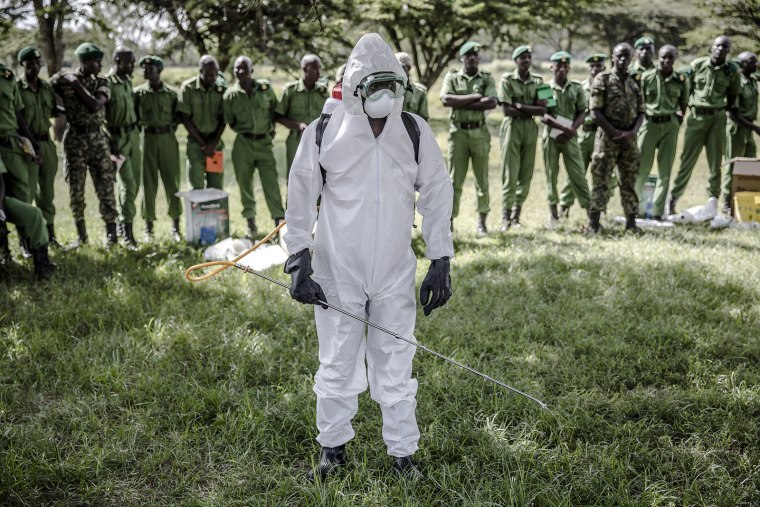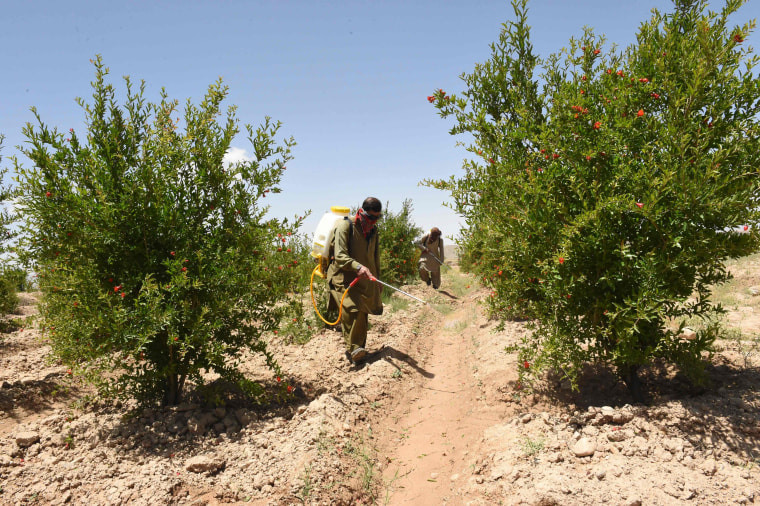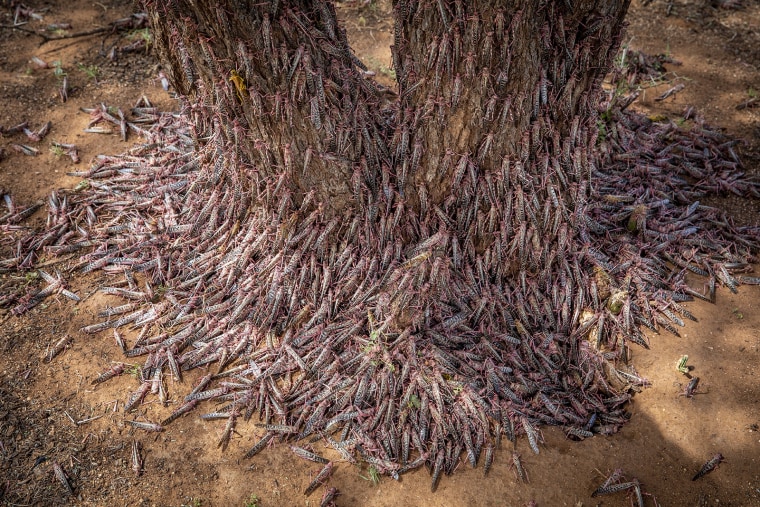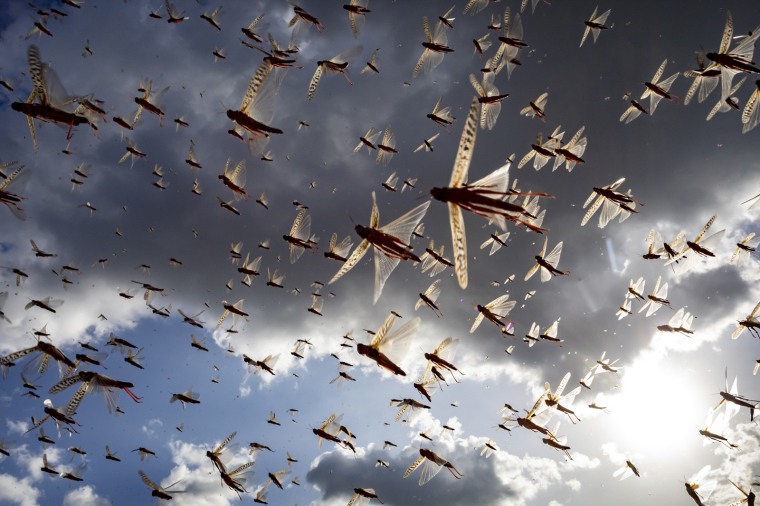When the skies darkened suddenly over Michael Gatiba's 10-acre farm in Nakuru County, Kenya, what came pouring down stunned him: millions of desert locusts.
"It was like a storm," Gatiba, 45, said by telephone. "It was like hail. They covered everywhere. Even there was no sun."
That was three months ago. Although Gatiba said he was lucky that the damage from the insects was minimal, he fears that the outbreak that has plagued swaths of Africa, the Middle East and Asia for the past two years will return to ravage his maize and bean crops.
As the pests begin to migrate again in the second half of June, experts warn that, without continuous aid to mitigate the spread, the devastation could leave millions of people in at least 23 countries hungry by the end of the year.
"There is nothing we can do. They are not here, but they might come," Gatiba said. The loss of his crops could leave him, his wife and their four children struggling. "I'm very worried," he said.

Desert locusts are a migratory pest from the grasshopper family. Even with a lifespan of only three months, they can, under the right conditions, multiply up to twentyfold in just one generation and mature to behave as a coherent unit, forming massive swarms that feast on green vegetation, according to the U.N. Food and Agriculture Organization, or FAO.
A perfect storm of favorable weather, poor monitoring — particularly in conflict zones — and challenges in getting access to resources and regions because of the coronavirus pandemic has sparked the crisis, allowing locusts to reach a scale unseen in decades, experts said.
"Even my grandfather didn't see these things," Gatiba said.
The locusts that have been feasting and reproducing in Kenya — as well as in Ethiopia, Somalia and Djibouti — are expected to begin another move with the changing winds by the end of the month, with some bound for Sudan.
There are fears that the insects could move even farther into West Africa, threatening some of the poorest countries in the world, said Melissa Williams, a senior rural development specialist for the World Bank. Meanwhile, other swarms that in recent weeks have feasted in India and Pakistan — especially Punjab and Sindh provinces — could cycle through the region.
"This is the worst transboundary pest in the world," Williams said. "They don't need passports, so they'll just keep going."
Download the NBC News app for breaking news and alerts
Still, international agencies and local governments have made significant progress.
"It's about 450 billion insects that we killed since the beginning of the year," Cyril Ferrand, head of the FAO's resilience team in East Africa, said of estimates that more than 1.1 million acres were brought under control by the FAO and the various governments.
The success is due to extensive on-the-ground monitoring of the insects. "Only when you have identified targets, you can send the plane to spray," he said.
Spraying pesticides is the most effective way to control desert locusts, and countries accustomed to them — such as Sudan and Eritrea — have strong programs to keep the populations at bay.
But monitoring and spraying weren't happening in remote areas of the Arabian Peninsula in 2018 — notably in war-torn Yemen — following plentiful rain, including two cyclones from the Indian Ocean that created lush vegetation in which the locusts could grow and thrive.
"Normally, the first line of defense is Yemen," Williams said. But "the funds aren't there, and it's very difficult to access, because you're crossing lines of conflict, and so things got out of control."

Launching campaigns in peaceful jurisdictions wasn't instantaneous, either. Many countries now being hit by swarms of the pests haven't seen locusts in recent memory and don't have the expertise to deal with them, Ferrand said. The last outbreak in Kenya was 70 years ago, while Uganda last saw locusts 60 years ago.
"It's like in the U.S., in the South, nobody invests in snow removal equipment," Williams said, because most years it isn't needed.
While officials were scrambling to respond to the swarms, the coronavirus pandemic proved to be another barrier.
Experts and equipment were brought in just before borders closed, Ferrand said. The FAO also strategically procured resources, such as pesticide, in batches rather than in single mass orders in case shipments were disrupted.
Once lockdowns were imposed to prevent the spread of the virus, people involved in responding to the locusts were made exempt from the rules. "That's to the credit of governments, which elevated desert locusts to a national priority," Ferrand said. "So despite the curfew and the restriction of movement of people, all our field staff are able to move."
In addition to the immediate response, private companies and international agencies, including the World Bank, which announced $500 million in aid, are piloting technological solutions to react better to future outbreaks.
Drones to monitor and deploy small batches of pesticides are being tested in hard-to-reach areas of Kenya, Williams said. Satellite imagery of Ethiopia, captured by the European Space Agency, was used to track when locusts were detected compared with the destruction left behind and to determine whether such imagery can aid in monitoring future outbreaks.
"The issue is which technologies are going to be the most useful and most sustainable," Williams said.
In addition to focusing on mitigating the locusts, agencies and governments are racing to address the pressing concern of food availability. A 1-kilometer swarm can consume as much food as 35,000 people in a single day, according to the FAO.

Cash transfers to individuals are providing immediate incentives for farmers to stay on their land, rather than turn to other jobs in desperation and risk abandoning their livelihoods, which their communities also benefit from, Ferrand said.
Farmers are also being trained on sustainable agriculture practices — programs already in place for adapting to the changing climate, extreme weather and other challenges — to ensure that they can thrive after the locust crisis. Pastoralists are also being provided feed for their cattle to compensate for lost grazing lands.
"We don't want more people to be dependent on food assistance. We want people to stay where they are. We want people to keep their productive assets," Ferrand said.
Still, the situation remains dire. More than 20 million people across the Horn of Africa already had insufficient access to food, according to the FAO. Worst-case projections could see 5 million more people experience hunger — and as of now, they're halfway there, Ferrand said.
In April, the World Food Program's head, David Beasley, warned the U.N. Security Council of a looming "hunger pandemic." The combination of crises from wars to the burgeoning locust plague could result in as many as 300,000 deaths a day from starvation by the end of the year, he said.
And funding for the agencies is running low. The World Food Program's operations supporting refugees in East Africa and the Horn of Africa faced a shortfall of $103 million, the organization said in a statement in May.
The FAO's operations can be supported only until the end of August, Ferrand said, while the swarms are expected to continue to reproduce and spread through the year's end. "We are winning, but we didn't win yet," he said. "There is a real risk here that all our efforts since January are in vain."
While the FAO renews its funding appeals to governments and the public worldwide to ensure that it can maintain its victory over the outbreak, farmers like Gatiba in Kenya watch the skies with concern. Losing a major harvest like maize due to be ripe in the next two months could spell disaster for paying his four children's school tuition, he said.
"There is nothing we can do, because if they destroy [crops], it's a very big loss," he said. "I would try to be helped by the government or anybody who is willing."

